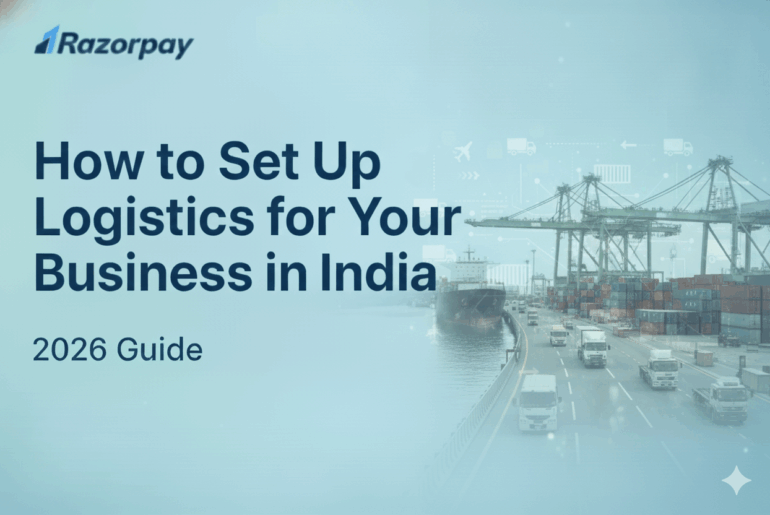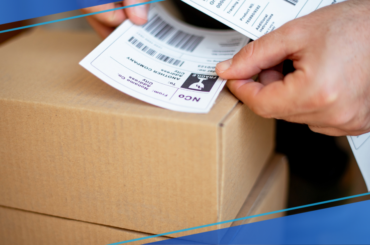You’ve built a great product, your online store is ready, and the first orders are coming in. Now comes the most critical challenge: how do you actually get that product from your desk to your customer’s doorstep, whether they are in Mumbai, Madurai, or Shillong?
For a new startup or merchant in India, logistics can seem like a complex maze of warehouses, courier partners, compliance paperwork, and hidden costs. Setting it up incorrectly can lead to high costs, delayed deliveries, and unhappy customers.
This guide will demystify the process. We will not focus on how to become a logistics company, but on how to build an efficient, scalable logistics system for your e-commerce or D2C business. We will cover the three pillars you must get right: the Model (how you operate), the Compliance (how you stay legal), and the Technology (how you optimize).
Key Takeaways
Your First Decision: The Model. Your most critical choice is your logistics model: In-House (doing it all yourself), 3PL (Third-Party Logistics) (outsourcing storage and fulfillment), or a Shipping Aggregator (a tech platform to book couriers). This choice impacts your cost, control, and ability to scale.
- The #1 GST Compliance Trap: APOB: If you use a 3PL warehouse in a state different from your primary registration, you are legally required to register that warehouse as an APOB (Additional Place of Business) under your own GSTIN. Failure to do so can lead to penalties and loss of tax benefits.
- Tech is Included, Not an Extra: You do not need to buy expensive, standalone Warehouse Management System (WMS) or Transport Management System (TMS) software. Modern 3PLs and shipping aggregators include this technology as part of their service.
- Link Payments & Logistics to Survive: In India, managing RTO (Return to Origin) risk, especially from Cash on Delivery (COD) orders, is a primary financial drain. Your logistics setup is incomplete without integrating it with your payment system to manage this risk.
Step 1: Choose Your Logistics Model (The Core Decision)
This is the foundational choice that will define your costs and operational capacity. There are three primary models for an Indian merchant.
Model 1: In-House Logistics (The Control Path)
What it is: You manage every step of the process yourself. This includes leasing a warehouse, hiring staff to manage inventory and pack orders, and signing individual contracts with courier companies.
- Pros: 100% control over the customer experience, from custom-branded packaging to quality checks.
- Cons: Requires extremely high upfront capital for rent, salaries, and infrastructure. It is very difficult to scale up or down to meet demand.
- Best for: Large, well-funded businesses or those with highly specialized needs like cold storage.
Model 2: Third-Party Logistics (3PL) (The Scaling Path)
What it is: You outsource the entire physical fulfillment process. You send your inventory to a 3PL’s warehouse. When an order comes in, their team picks, packs, and ships it for you.
- Pros: This is an “asset-light” model. You get access to a professional warehouse and fulfillment team without the capital cost. It’s highly scalable—you pay as you go, so your costs scale directly with your sales.
- Cons: You give up some control over the final pack-out. This model also has the critical APOB compliance requirement (see Step 2).
- Best for: Scaling D2C brands and e-commerce sellers who want to automate their physical operations.
Model 3: Shipping Aggregators (The “Plug-and-Play” Path)
What it is: This is a technology platform, not a physical warehouse. A shipping aggregator is a software that connects your online store to dozens of courier partners through a single dashboard.
- Pros: Instant access to a nationwide delivery network with pre-negotiated, discounted shipping rates. The platform provides powerful tools like bulk order uploads, automated label generation, and unified tracking.
- Cons: You still manage your own inventory and packing. This model only solves the shipping part, not the warehousing.
- Best for: Startups and home-based businesses who pack their own orders but need a simple, cheap, and powerful way to ship them.
Step 2: Navigate the Must-Have Legal & GST Compliance
Once you have a model, you must ensure it’s legally compliant. For an Indian merchant, this centers on your GST obligations.
The Most Important GST Rule: APOB (Additional Place of Business)
This is the single biggest compliance trap for growing e-commerce businesses.
- What it is: Your primary office address on your GST certificate is your PPOB (Principal Place of Business). Under GST law, any other location where you store your inventory is considered an APOB (Additional Place of Business).
- Why it Matters: When you use a 3PL or an Amazon FBA warehouse, you are storing your goods at their location. That location legally becomes your APOB. You must file an amendment on the GST portal to add that warehouse address to your own GST certificate.
- The Consequence: If you don’t register the APOB, you are non-compliant. This means you cannot legally issue an invoice from that location, and more importantly, you cannot claim Input Tax Credit (ITC) on the warehousing, packing, and other services you are paying the 3PL for.
- Actionable Advice: Before signing a contract, ask your 3PL provider for the documents needed for your APOB registration, which usually includes a copy of their lease agreement and a No Objection Certificate (NOC).
The E-Way Bill: Your “License to Move Goods”
- What it is: An E-Way Bill is a mandatory electronic document generated from the GST portal.
- When you need it: It is required for any movement of goods—whether for a sale or a stock transfer to your 3PL—where the total value of the consignment exceeds ₹50,000.
- Who generates it: The person causing the movement is responsible. This could be you (when sending stock to the warehouse), your 3PL (when shipping to a customer), or the transport company.
- What you need: To generate one, you’ll need the invoice or delivery challan, the HSN code of your goods, and the transporter’s ID or the vehicle number.
Step 3: Build Your Technology & Fulfillment Stack
Many founders get overwhelmed by acronyms. The good news is that if you choose the right model, the technology is often included.
The “Startup-Friendly” Tech Stack
- Do I need a WMS (Warehouse Management System)? A WMS is software that tracks every item in your warehouse.
- If you use a 3PL: No. Your 3PL partner provides their own WMS, and you get a dashboard to see your inventory.
- If you are In-House: Yes. You can start with cloud-based inventory management software.
- Do I need a TMS (Transport Management System)? A TMS is software that plans routes and manages courier partners.
- No. If you use a Shipping Aggregator, their platform is your TMS. Their software is what allows you to compare carrier rates, print labels, and track shipments in one place.
Don’t Forget Reverse Logistics (Product Returns)
In India, logistics is not just a one-way street. Managing product returns (reverse logistics) is just as important as shipping them out.
- The Problem: Returns are a massive cost, especially with Cash on Delivery (COD). Processing a single return can cost more than the original delivery.
- Your Plan: You must have a two-part plan:
- A Clear Policy: Your website must have a simple, clear, and visible return policy.
- A Physical Process: Your 3PL or shipping aggregator will provide a “reverse pickup” service. You need a process to inspect the returned item and decide whether to restock it or write it off.
Step 4: Connect Logistics to Payments to Reduce Risk
Setting up your shipping is only half the battle. In India, your logistics system is incomplete if it’s not tightly integrated with your payment and risk management systems.
The “RTO” Problem: India’s Biggest Logistics Risk
RTO (Return to Origin) is a failed delivery. The package is sent back to you because the customer refused it, provided a fake address, or was unavailable.
- The Cause: The number one cause of RTO in India is the misuse of Cash on Delivery (COD) orders.
- The Cost: RTO is a total financial loss. You pay for the forward shipping, the packaging, and the return shipping, all for zero revenue.
You cannot just “manage” RTO; you must prevent it. This is where your logistics and payment systems must work together.
Supercharge Your Logistics with Smart Payments
By integrating your logistics and payment platforms, you create a powerful, automated system that protects your revenue.
- Solve RTO Before It Happens: Don’t just manage RTO, prevent it. Modern payment solutions can integrate with your logistics partners and use a powerful RTO intelligence engine. They can automatically detect high-risk COD orders (based on a customer’s address and past behavior) and give you the power to disable the COD option just for those risky orders. This saves you from the RTO loss before you even pack the box.
- Automate COD Refunds: Handling COD returns is a manual, slow process. Integrated payment platforms can automate this entire flow. When your warehouse confirms a return, you can trigger a refund instantly via API or a dashboard, 24/7. This stops customer complaints, builds loyalty, and makes your financial reconciliation simple.
Simplify Financial Workflows with Razorpay
Streamline your financial operations by automating collections, invoicing, and reconciliation—all while staying compliant and maintaining full visibility across your business.
Learn how Razorpay empowers businesses to scale efficiently with smarter financial infrastructure.
Conclusion
Setting up logistics in India is no longer an impossible hurdle for startups. The ecosystem of specialized 3PLs, powerful shipping aggregators, and integrated payment platforms has made it more accessible than ever.
Your path to a scalable logistics system is clear:
- Choose the right model for your current stage (likely an aggregator or a 3PL).
- Nail your GST compliance from day one, especially the APOB rules.
- Integrate your payments and logistics to aggressively manage RTO risk.
By focusing on these three steps, you can build a business logistics system that is not a cost center, but a powerful engine for customer satisfaction and growth.
Frequently Asked Questions (FAQs)
What’s the real difference between a 3PL and a shipping aggregator?
A 3PL (Third-Party Logistics) provider physically stores your inventory in their warehouse and fulfills your orders (they pick, pack, and ship). A shipping aggregator is a software platform that connects your store to multiple couriers. You still store and pack your own orders.
What is APOB in GST and why do I need it?
APOB stands for Additional Place of Business. If you store your inventory in any location other than your main registered office (like a 3PL warehouse), you must add that warehouse address as an APOB to your GST certificate. It is a mandatory compliance step.
Do I need to buy separate WMS or TMS software?
Almost certainly no. When you are starting out, your 3PL partner will provide the WMS (Warehouse Management System) functions. Your shipping aggregator’s platform is your TMS (Transport Management System); it allows you to manage all your carriers and shipments.
What is an E-Way Bill?
An E-Way Bill is a mandatory electronic document. It is required for transporting any goods (including shipping to your warehouse or to a customer) where the total value of the goods in the vehicle is over ₹50,000.
What is RTO and how can I reduce it?
RTO stands for Return to Origin. This is when a delivery fails (most often a COD rejection or fake address) and the package is sent back to you. You lose money on both the forward and reverse shipping. The best way to reduce it is to use a smart checkout system that identifies high-risk COD orders and allows you to block them before you ship the product.


